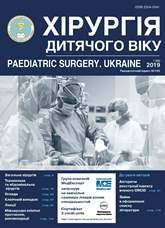Modern methods of diagnosing benign and malignant lung neoplasms in children (a literature review)
DOI:
https://doi.org/10.15574/PS.2019.62.82Keywords:
Lung neoplasms, pediatrics, surgeryAbstract
In this review, the most common methods of diagnosing in pediatric practice, both benign and malignant neoplasms, their disadvantages and the possibility of the latest methods using are considered. In recent years, the literature suggests the use of positron emission tomography-computed tomography (PET-CT) and bronchoscopy as the most relevant and progno tically valid. A retrospective analysis of childhood patients diagnostic methods, operated on tumors and metastatic lung defect, was conducted on the basis of the Kyiv Clinical Hospital No.17 Children’s Thoracic Surgery Department and on the basis of the National Cancer Institute Children’s Oncology Department (Kyiv) for the period from 2000 to 2016 to determine the most commonly used methods.References
Kliusov OM, Firsova MM, Osynskyi DS ta in. (2012). Zastosuvannia poiednanoho PET-KT doslidzhennia v diahnostytsi onkolohichnykh zakhvoriuvan. Onkolohiia. 14;1.
Kostromina VP, Stryzh VO, Lomtieva LF, Melnyk KO. (2010). Dyferentsialna diahnostyka kuliastykh utvoren leheniv u ditei. Dytiachyi likar, 3(5).
Pro zatverdzhennia protokoliv nadannia medychnoi dopomohy za spetsialnistiu «Onkolohiia»: nakaz MOZ Ukrainy vid 17.09.2007 No. 554. http://www.moz.gov.ua.
Sokur PP, Kravchuk BO. (2013). Povtorni khirurhichni vtruchannia u ditei pry zakhvoriuvanniakh orhaniv dykhannia ta mezhystinnia. Ukrainskyi pulmonolohichnyi zhurnal. 3:221–222.
Scherbina OV, Moskalets AI. (2011). Teoreticheskie i kliniko-metodicheskie aspektyi pozitronnoy emissionnoy tomografii. Onkologiya.13; 3(49):251–5.
Bailey AG, Valley RD, Azizkhan RG et al. (1992). Anaesthetic management of infants requiring endobronchial argon laser surgery. Can J Anaesth. 39:590–3. https://doi.org/10.1007/BF03008324; PMid:1643683
Bury T, Dowlati A, Paulus P et al. (1996). Evaluation of the solitary pulmonary nodule by positron emission tomography imaging. Eur Respir J. 9:410–4. https://doi.org/10.1183/09031936.96.09030410; PMid:8729997
Cohen MC, Kaschula RO. (1992). Primary pulmonary tumors in childhood: a review of 31 years’ experience and the literature. Pediatr Pulmonol.14:222–232. https://doi.org/10.1002/ppul.1950140405; PMid:1336597
Dakshesh H. (2009). Parikh Pediatric Thoracic Surgery. Lung Tumors.
Dishop MK, Kuruvilla S. (2008). Primary and metastatic lung tumors in the pediatric population: a review and 25-year experience at a large children’s hospital. Arch Pathol Lab Med. 132:1079–1103.
Efrati O, Sadeh-Gornik U, Modan-Moses D et al. (2009, Jan). Flexible bronchoscopy and bronchoalveolar lavage in pediatric patients with lung disease. Pediatr Crit Care Med. 10(1):80–4. https://doi.org/10.1097/PCC.0b013e31819372ea; PMid:19057431
Facey K, Bradbury I, Laking G, Payne E. (2007). Overview of the clinical effectiveness of positron emission tomography imaging in selected cancers. Health Technol Assess. 11(44): ІІІ–ІV. https://doi.org/10.3310/hta11440; PMid:17999839
Gupta N, Gill H, Graeber G et al. (1998). Dynamic positron emission tomography with F-fluorodeoxyglucose imaging in differentiation of benign from malignant lung/mediastinal lesions. Chest. 114:1105–11. https://doi.org/10.1378/chest.114.4.1105
Husain NA, Kumar V. The Lung (2004). In: Kumar V, Abbas KA, Fausto N, (Eds). Pathologic Basis Of Diseases. Pennsylvania: Elsevier: 759.
Jacobs IN. Bronchoscopy (2011). In: Mattei P. (Editor). Fundamentals of Pediatric Surgery. New York: Springer:185–94. https://doi.org/10.1007/978-1-4419-6643-8_25
Juweid ME, Cheson BD. (2006). Positron-emission tomography and assessment of cancer therapy. N Engl J Med. 354:496–507. https://doi.org/10.1056/NEJMra050276; PMid:16452561
Lardinois D, Weder W, Hany TF et al. (2003). Staging of nonsmall cell lung cancer with integrated positron-emission tomography and computed tomography. N Engl J Med. 348:2500–7. https://doi.org/10.1056/NEJMoa022136; PMid:12815135
Masters IB, Cooper P. (2002). Paediatric flexible bronchoscopy. J Paediatr Child Health. 38:555–9. https://doi.org/10.1046/j.1440-1754.2002.00058.x; PMid:12410865
Perez-Frias J, Moreno Galdo A, Perez Ruiz E et al. (2011). Pediatric bronchoscopy guidelines. Arch Bronconeumol. 47:350–60. https://doi.org/10.1016/j.arbr.2011.04.001
Rizzardi G, Bertolaccini L, Terzі A. (2011). Bronchial Carcinoid Tumours in Children–A Review January 2011 European Oncology and Haematology. 07(03). https://doi.org/10.17925/EOH.2011.07.03.196
Sinha V, Gurnani D, Barot DA. (2014). A study of applications of rigid bronchoscopy in pediatric patients. Indian J Otolaryngol Head Neck Surg.66:142–4. https://doi.org/10.1007/s12070-013-0667-1; PMid:24822151 PMCid:PMC4016352
Subhalakshmi S, Uttara C, Ranjana B, Kuntal B, Sugata B. (2011, Oct-Dec). Primary pulmonary neoplasms in children: A report of five cases. Indian J Med Paediatr Oncol. 32(4):223–226. https://doi.org/10.4103/0971-5851.95146; PMid:22563158 PMCid:PMC3343251
Tischer W, Reddemann H, Herzog P et al. (1987). Experience in surgical treatment of pulmonary and bronchial tumours in childhood. Prog Pediatr Surg. 21:118–135. https://doi.org/10.1007/978-3-642-71665-2_16; PMid:3107068
Weldon CB, Shamberger RC. (2008, Feb). Pediatric pulmonary tumors: primary and metastatic. Semin Pediatr Surg. 17(1):17–29. https://doi.org/10.1053/j.sempedsurg.2007.10.004; PMid:18158138
Welsh JH, Maxson T, Jaksic T, Shahab I, Hicks J. (1998). Tracheobronchial mucoepidermoid carcinoma in childhood and adolescence: case report and review of the literature. Int J Pediatr Otorhinolaryngol. 45:265–273. https://doi.org/10.1016/S0165-5876(98)00120-7
Wood RE, Daines C. (2012). Bronchscopy and bronchoalveolar lavage in pediatric patients. In: Wilmott RW, Bush A, Boat TF. (Eds.). Kending and Chernick’s Disorders of the Respiratory Tract in Children. Eight edition. Philadelphia: Saunders: 94–109. https://doi.org/10.1016/B978-0-7216-3695-5.50011-0; PMCid:PMC2277294
Downloads
Issue
Section
License
The policy of the Journal “PAEDIATRIC SURGERY. UKRAINE” is compatible with the vast majority of funders' of open access and self-archiving policies. The journal provides immediate open access route being convinced that everyone – not only scientists - can benefit from research results, and publishes articles exclusively under open access distribution, with a Creative Commons Attribution-Noncommercial 4.0 international license(СС BY-NC).
Authors transfer the copyright to the Journal “PAEDIATRIC SURGERY.UKRAINE” when the manuscript is accepted for publication. Authors declare that this manuscript has not been published nor is under simultaneous consideration for publication elsewhere. After publication, the articles become freely available on-line to the public.
Readers have the right to use, distribute, and reproduce articles in any medium, provided the articles and the journal are properly cited.
The use of published materials for commercial purposes is strongly prohibited.

